Linlin Yang
MedFact-R1: Towards Factual Medical Reasoning via Pseudo-Label Augmentation
Sep 18, 2025Abstract:Ensuring factual consistency and reliable reasoning remains a critical challenge for medical vision-language models. We introduce MEDFACT-R1, a two-stage framework that integrates external knowledge grounding with reinforcement learning to improve the factual medical reasoning. The first stage uses pseudo-label supervised fine-tuning (SFT) to incorporate external factual expertise; while the second stage applies Group Relative Policy Optimization (GRPO) with four tailored factual reward signals to encourage self-consistent reasoning. Across three public medical QA benchmarks, MEDFACT-R1 delivers up to 22.5% absolute improvement in factual accuracy over previous state-of-the-art methods. Ablation studies highlight the necessity of pseudo-label SFT cold start and validate the contribution of each GRPO reward, underscoring the synergy between knowledge grounding and RL-driven reasoning for trustworthy medical AI. Codes are released at https://github.com/Garfieldgengliang/MEDFACT-R1.
Squeeze10-LLM: Squeezing LLMs' Weights by 10 Times via a Staged Mixed-Precision Quantization Method
Jul 24, 2025Abstract:Deploying large language models (LLMs) is challenging due to their massive parameters and high computational costs. Ultra low-bit quantization can significantly reduce storage and accelerate inference, but extreme compression (i.e., mean bit-width <= 2) often leads to severe performance degradation. To address this, we propose Squeeze10-LLM, effectively "squeezing" 16-bit LLMs' weights by 10 times. Specifically, Squeeze10-LLM is a staged mixed-precision post-training quantization (PTQ) framework and achieves an average of 1.6 bits per weight by quantizing 80% of the weights to 1 bit and 20% to 4 bits. We introduce Squeeze10LLM with two key innovations: Post-Binarization Activation Robustness (PBAR) and Full Information Activation Supervision (FIAS). PBAR is a refined weight significance metric that accounts for the impact of quantization on activations, improving accuracy in low-bit settings. FIAS is a strategy that preserves full activation information during quantization to mitigate cumulative error propagation across layers. Experiments on LLaMA and LLaMA2 show that Squeeze10-LLM achieves state-of-the-art performance for sub-2bit weight-only quantization, improving average accuracy from 43% to 56% on six zero-shot classification tasks--a significant boost over existing PTQ methods. Our code will be released upon publication.
MLVTG: Mamba-Based Feature Alignment and LLM-Driven Purification for Multi-Modal Video Temporal Grounding
Jun 10, 2025Abstract:Video Temporal Grounding (VTG), which aims to localize video clips corresponding to natural language queries, is a fundamental yet challenging task in video understanding. Existing Transformer-based methods often suffer from redundant attention and suboptimal multi-modal alignment. To address these limitations, we propose MLVTG, a novel framework that integrates two key modules: MambaAligner and LLMRefiner. MambaAligner uses stacked Vision Mamba blocks as a backbone instead of Transformers to model temporal dependencies and extract robust video representations for multi-modal alignment. LLMRefiner leverages the specific frozen layer of a pre-trained Large Language Model (LLM) to implicitly transfer semantic priors, enhancing multi-modal alignment without fine-tuning. This dual alignment strategy, temporal modeling via structured state-space dynamics and semantic purification via textual priors, enables more precise localization. Extensive experiments on QVHighlights, Charades-STA, and TVSum demonstrate that MLVTG achieves state-of-the-art performance and significantly outperforms existing baselines.
Rethinking Metrics and Benchmarks of Video Anomaly Detection
May 25, 2025Abstract:Video Anomaly Detection (VAD), which aims to detect anomalies that deviate from expectation, has attracted increasing attention in recent years. Existing advancements in VAD primarily focus on model architectures and training strategies, while devoting insufficient attention to evaluation metrics and benchmarks. In this paper, we rethink VAD evaluation protocols through comprehensive experimental analyses, revealing three critical limitations in current practices: 1) existing metrics are significantly influenced by single annotation bias; 2) current metrics fail to reward early detection of anomalies; 3) available benchmarks lack the capability to evaluate scene overfitting. To address these limitations, we propose three novel evaluation methods: first, we establish averaged AUC/AP metrics over multi-round annotations to mitigate single annotation bias; second, we develop a Latency-aware Average Precision (LaAP) metric that rewards early and accurate anomaly detection; and finally, we introduce two hard normal benchmarks (UCF-HN, MSAD-HN) with videos specifically designed to evaluate scene overfitting. We report performance comparisons of ten state-of-the-art VAD approaches using our proposed evaluation methods, providing novel perspectives for future VAD model development.
Analyzing the Synthetic-to-Real Domain Gap in 3D Hand Pose Estimation
Mar 25, 2025



Abstract:Recent synthetic 3D human datasets for the face, body, and hands have pushed the limits on photorealism. Face recognition and body pose estimation have achieved state-of-the-art performance using synthetic training data alone, but for the hand, there is still a large synthetic-to-real gap. This paper presents the first systematic study of the synthetic-to-real gap of 3D hand pose estimation. We analyze the gap and identify key components such as the forearm, image frequency statistics, hand pose, and object occlusions. To facilitate our analysis, we propose a data synthesis pipeline to synthesize high-quality data. We demonstrate that synthetic hand data can achieve the same level of accuracy as real data when integrating our identified components, paving the path to use synthetic data alone for hand pose estimation. Code and data are available at: https://github.com/delaprada/HandSynthesis.git.
Language-guided Open-world Video Anomaly Detection
Mar 17, 2025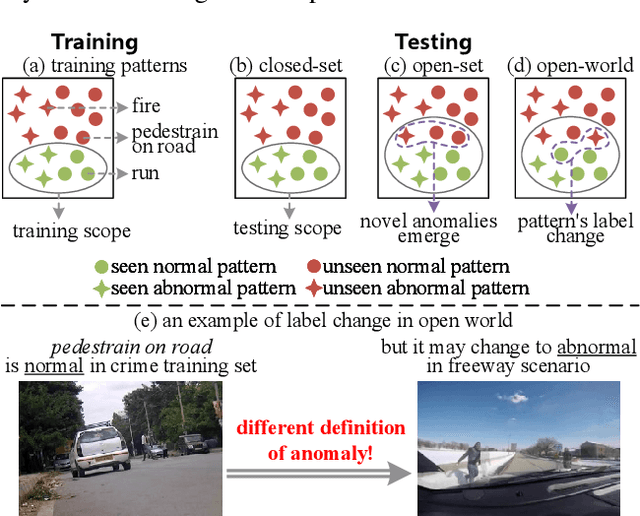
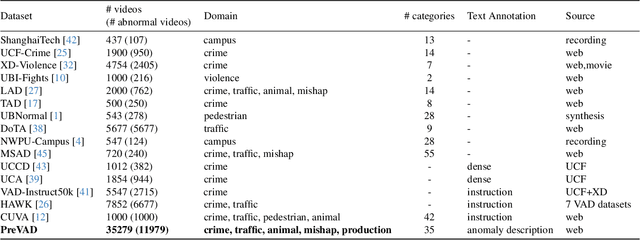
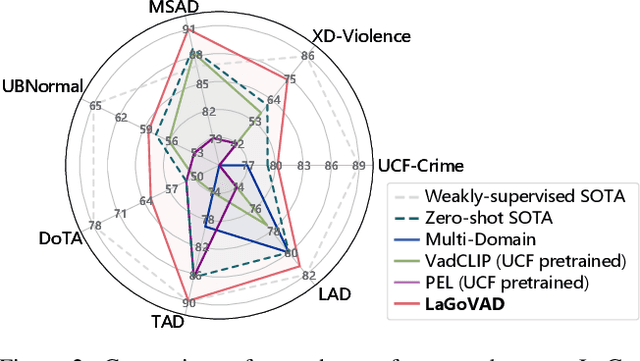
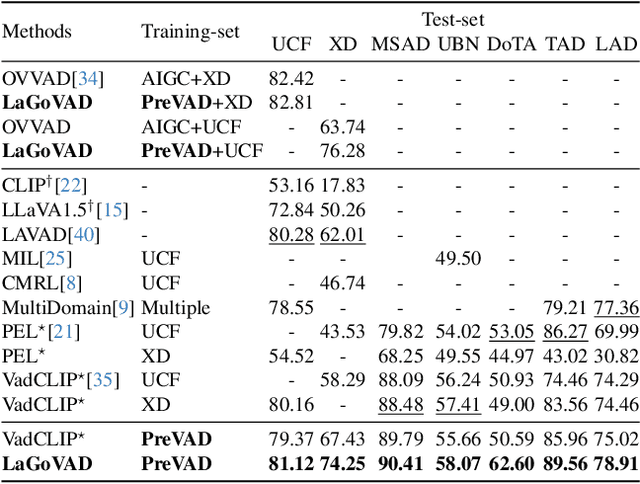
Abstract:Video anomaly detection models aim to detect anomalies that deviate from what is expected. In open-world scenarios, the expected events may change as requirements change. For example, not wearing a mask is considered abnormal during a flu outbreak but normal otherwise. However, existing methods assume that the definition of anomalies is invariable, and thus are not applicable to the open world. To address this, we propose a novel open-world VAD paradigm with variable definitions, allowing guided detection through user-provided natural language at inference time. This paradigm necessitates establishing a robust mapping from video and textual definition to anomaly score. Therefore, we propose LaGoVAD (Language-guided Open-world VAD), a model that dynamically adapts anomaly definitions through two regularization strategies: diversifying the relative durations of anomalies via dynamic video synthesis, and enhancing feature robustness through contrastive learning with negative mining. Training such adaptable models requires diverse anomaly definitions, but existing datasets typically provide given labels without semantic descriptions. To bridge this gap, we collect PreVAD (Pre-training Video Anomaly Dataset), the largest and most diverse video anomaly dataset to date, featuring 35,279 annotated videos with multi-level category labels and descriptions that explicitly define anomalies. Zero-shot experiments on seven datasets demonstrate SOTA performance. Data and code will be released.
Online Test-time Adaptation for 3D Human Pose Estimation: A Practical Perspective with Estimated 2D Poses
Mar 14, 2025


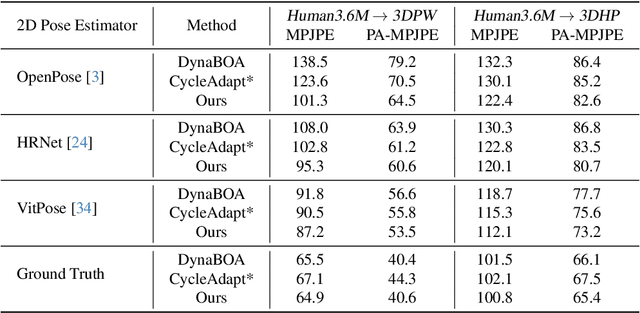
Abstract:Online test-time adaptation for 3D human pose estimation is used for video streams that differ from training data. Ground truth 2D poses are used for adaptation, but only estimated 2D poses are available in practice. This paper addresses adapting models to streaming videos with estimated 2D poses. Comparing adaptations reveals the challenge of limiting estimation errors while preserving accurate pose information. To this end, we propose adaptive aggregation, a two-stage optimization, and local augmentation for handling varying levels of estimated pose error. First, we perform adaptive aggregation across videos to initialize the model state with labeled representative samples. Within each video, we use a two-stage optimization to benefit from 2D fitting while minimizing the impact of erroneous updates. Second, we employ local augmentation, using adjacent confident samples to update the model before adapting to the current non-confident sample. Our method surpasses state-of-the-art by a large margin, advancing adaptation towards more practical settings of using estimated 2D poses.
Prompt as Knowledge Bank: Boost Vision-language model via Structural Representation for zero-shot medical detection
Feb 22, 2025Abstract:Zero-shot medical detection can further improve detection performance without relying on annotated medical images even upon the fine-tuned model, showing great clinical value. Recent studies leverage grounded vision-language models (GLIP) to achieve this by using detailed disease descriptions as prompts for the target disease name during the inference phase. However, these methods typically treat prompts as equivalent context to the target name, making it difficult to assign specific disease knowledge based on visual information, leading to a coarse alignment between images and target descriptions. In this paper, we propose StructuralGLIP, which introduces an auxiliary branch to encode prompts into a latent knowledge bank layer-by-layer, enabling more context-aware and fine-grained alignment. Specifically, in each layer, we select highly similar features from both the image representation and the knowledge bank, forming structural representations that capture nuanced relationships between image patches and target descriptions. These features are then fused across modalities to further enhance detection performance. Extensive experiments demonstrate that StructuralGLIP achieves a +4.1\% AP improvement over prior state-of-the-art methods across seven zero-shot medical detection benchmarks, and consistently improves fine-tuned models by +3.2\% AP on endoscopy image datasets.
Normalizing Batch Normalization for Long-Tailed Recognition
Jan 06, 2025



Abstract:In real-world scenarios, the number of training samples across classes usually subjects to a long-tailed distribution. The conventionally trained network may achieve unexpected inferior performance on the rare class compared to the frequent class. Most previous works attempt to rectify the network bias from the data-level or from the classifier-level. Differently, in this paper, we identify that the bias towards the frequent class may be encoded into features, i.e., the rare-specific features which play a key role in discriminating the rare class are much weaker than the frequent-specific features. Based on such an observation, we introduce a simple yet effective approach, normalizing the parameters of Batch Normalization (BN) layer to explicitly rectify the feature bias. To achieve this end, we represent the Weight/Bias parameters of a BN layer as a vector, normalize it into a unit one and multiply the unit vector by a scalar learnable parameter. Through decoupling the direction and magnitude of parameters in BN layer to learn, the Weight/Bias exhibits a more balanced distribution and thus the strength of features becomes more even. Extensive experiments on various long-tailed recognition benchmarks (i.e., CIFAR-10/100-LT, ImageNet-LT and iNaturalist 2018) show that our method outperforms previous state-of-the-arts remarkably. The code and checkpoints are available at https://github.com/yuxiangbao/NBN.
DecomCAM: Advancing Beyond Saliency Maps through Decomposition and Integration
May 29, 2024Abstract:Interpreting complex deep networks, notably pre-trained vision-language models (VLMs), is a formidable challenge. Current Class Activation Map (CAM) methods highlight regions revealing the model's decision-making basis but lack clear saliency maps and detailed interpretability. To bridge this gap, we propose DecomCAM, a novel decomposition-and-integration method that distills shared patterns from channel activation maps. Utilizing singular value decomposition, DecomCAM decomposes class-discriminative activation maps into orthogonal sub-saliency maps (OSSMs), which are then integrated together based on their contribution to the target concept. Extensive experiments on six benchmarks reveal that DecomCAM not only excels in locating accuracy but also achieves an optimizing balance between interpretability and computational efficiency. Further analysis unveils that OSSMs correlate with discernible object components, facilitating a granular understanding of the model's reasoning. This positions DecomCAM as a potential tool for fine-grained interpretation of advanced deep learning models. The code is avaible at https://github.com/CapricornGuang/DecomCAM.
 Add to Chrome
Add to Chrome Add to Firefox
Add to Firefox Add to Edge
Add to Edge